Ask AJ
Anthony Japour Visits the David Castillo Gallery
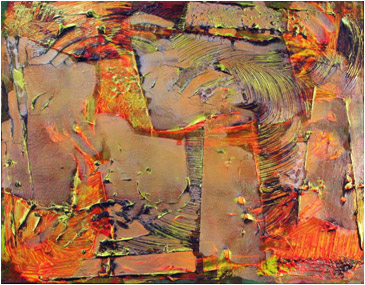

Anthony Japour (AJ) is an independent curator, private art dealer and owner of AJ Japour Gallery. The gallery deals in contemporary art with a focus on the Chinese Contemporary Art Movement and its relationship to the pillars of Western Contemporary Art. Since 2003, AJ has produced numerous art exhibitions and installations in Miami and South Florida. In addition, the Gallery’s secondary mission is to support organizations dedicated to the health, education, and welfare of children. AJ has served on the Fine Arts Board and the Cultural Arts Council of the City of Miami Beach.
When Art Basel Miami Beach first came to Miami Beach in 2002 [postponed from 2001 because of the tragic events of 911] it instantly put Miami on the map as one of the most important art destinations in the United States. With it, many exciting new galleries have sprouted up in the Wynwood Arts District.
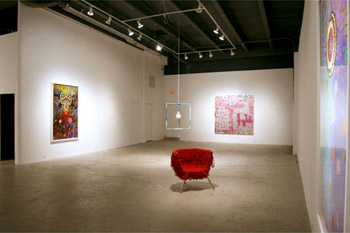
In 2009, David Lombardi, Tony Goldman and Thea Goldman founded the Wynwood Arts District Association with the mission to promote Wynwood as the epicenter of the arts and creative businesses in Greater Miami while enhancing the character of the factory and warehouse district. One such venue is the David Costillo Gallery, which opened in 2005 in a dilapidated warehouse, and maintains a full program exhibiting emerging and mid-career artists.
A textural feel joins together two concurrent and complementary exhibitions at the space. In the Main Gallery Illusions Lounge features a lone Fernando + Humberto Campana Rope Chair, 1993, loaned by local Miami collector Craig Robins, adjacent to a mixed media Jose Alvarez work, The Arrival, 2008 on the wall. The idea is, perhaps, to lounge in the “chair” and breathe the vibrant colors of the Alvarez construction. However, we’re generally taught that we shouldn’t touch a work of art let alone “sit” on it. And while the chair looks like a chair, it’s made out of rope, so one isn’t sure to recommend sitting on it even if allowed. Of course, those that know the fanciful creations of the Campana Brothers understand that these chairs are well constructed, real chairs.
Jose Alvarez is a South Florida artist whose art works are memorable for their deceptive two-dimensional appearance but, in reality, are three-dimensional collages on paper. Alvarez utilizes porcupine quills and feathers in what has become signature materials for his shamanistic works. I first came upon his art works some years ago at the Moore Space in a collaborative effort they did with Sarah Gavlak’s Gallery from Palm Beach. Having myself been a molecular virologist in the past, I recall seeing what looked to me like viral particles exploding from a cell. Interestingly, the artist apparently does take his cues from science, namely, the astrophysics writings of Stephen Hawking and anthropological writings of Jeremy Narby. In addition to Alvarez’ mixed media works on view, a video work entitled Cosmic Geometry, 2008 is projected on a large wall suggesting to me the notion of “combination” and “recombination” in a fine art context.
As a direct countervailing force to Alvarez’ cosmic universe, is Brooklyn-based Keltie Ferris’, Candy Darling, a playful and grounded work on canvas that is wholly abstract and blurred with its layers of applied oil and acrylic paint that are then spray painted with another layer of oil paint.
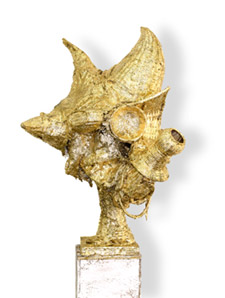
Illusions Lounge is rounded out by Nicole Cherubini’s terracotta and earthenware sculptures that look like paintings — in one instance, Box #8, 2010 is something that looks like a crushed cardboard box!
In the Annex, Gallery Projects exhibits works by the gallery artists Adler Guerrier, Aramis Gutierrez, Quisqueya Henriquez, Susan Lee-Chun, Pepe Mar, Glexis Novoa, Leyden Rodriguez-Casanova, Frances Trombly and Wendy Wischer. While there is no expressed relationship between Gallery Projects and Illusions Lounge, it feels like a continuous flow particularly when one comes to Susan Lee-Chun’s video of Sue Rehearsals, 2010 where the artist herself plays a celebrity TV chef. In three separate monitors so you can view the work regardless of your stature, Lee-Chun has created a parody of what has become a formulaic television experience. While America continues to be the cultural melting pot of the world, I take from her video that there may remain a lingering desire to fit into a mold, in this case an “all-American blonde.” Lee-Chun creates her sets, and while I was told by David Castillo that the kitchen set was a two-dimensional cardboard painting, it sure looked to me like a regular kitchen.
Similarly, Frances Trombly creates stitched works that look like the real thing; I was simply amazed at the technical skill required to produce a work like Receipt (Community Thrift Store), 2010.
Pepe Mar, known for his wildly colorful collage sculptures, is experimenting with a monochromatic palate – gold leaf, a perfect choice in these economic times where gold prices continue to climb.
In Aramis Gutierrez’ Patty Kelly, 2010 (a beautifully rendered portrait of one of the 1980’s Robert Palmer girls) one sees the idealized beauty with an obvious blemish on her left cheek. Gutierrez forces the viewer to choose, or not to choose, to see the flaw or the incomprehensible. For me this work brought to mind the work of an emerging artist in the Chinese Contemporary art movement, Ling Jian, who plants flaws in perfection such as in Nameless, 2003 where he painted a perfect beauty with one almost imperceptible flaw- a bloodshot eye.
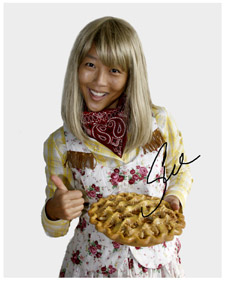
David Castillo Gallery
2234 NW 2nd Avenue
Miami, FL 33127
www.davidcastillogallery.com
Ask AJ
Dear AJ: I was given a [large] painting as a gift and I am trying to find out more about it. It is too large for my house and not my taste so I am thinking of selling it. I have tried researching on the Internet but could not find any information. — Samantha
Dear Samantha: I know you’d probably like to wiggle your nose and have that painting disappear. But it won’t be easy. One of the most important things I instruct my clients is to start an “Art File” and store as much information as you can for every work of art acquired. If you have made the purchase yourself, keep the bill of sale. As inconsequential value it may seem at the time it was acquired or gifted, art is a tangible asset and needs to be treated like one. If you are ever given a work of art as a gift, you should ask for the name of the artist, date of production, medium, size, and previous ownership. The chain of ownership of artwork is known as “provenance.” I suggest you go back to the person who gave you the painting and ask him/her to provide this information for you. You can then locate art dealers or galleries who are actively selling the artist’s works. You can also try to consult with a specialist at one of the auction houses.
Please email questions you’ve always wanted to ask, comments, or suggestions for future columns to Anthony Japour at info@ajjapourgallery.com
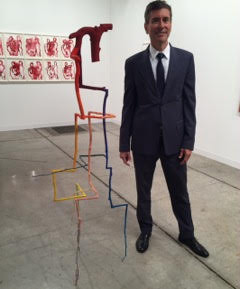
Anthony Japour is an art collector and art advisor. Japour lectures on the Chinese Contemporary Art Movement and its relationship to the pillars of Western Contemporary Art. For over a decade [2002-2012], Japour mounted numerous art exhibitions and installations in Miami Beach and South Florida through AJ Japour Gallery and linked these exhibitions to charity events at his home in South Beach devoted to the health, education and welfare of children. Japour has served on the Fine Arts Board and the Cultural Arts Council of the City of Miami Beach. Japour has been a contributor writing on contemporary art for SocialMiami.com since 2010.


